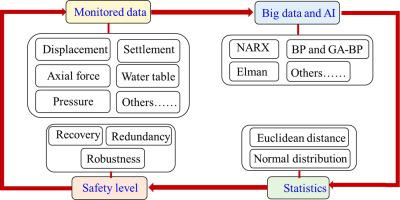Gondwana Research ( IF 6.1 ) Pub Date : 2022-05-27 , DOI: 10.1016/j.gr.2022.05.015 Chengyu Hong , Guangbin Luo , Weibin Chen

|
Rapid safety evaluation of foundation ditch during construction process has gained significant attention in recent years. In this study, safety monitoring of a foundation ditch was proposed using different sensing technologies including distributed fiber optic sensors (FOS) and micro-electro-mechanical (MEMS) sensors. Four different artificial neural network methods, including back propagation neural network, genetic algorithm optimized back propagation (GA-BP) neural network, nonlinear autoregressive network with exogenous inputs neural network, and Elman neural network, were used to predict the monitored axial force of concrete support, settlement of foundation ditch, and horizontal displacement of diagraph wall during construction process. The monitoring result shows both MEMS based sensors and FOS are effective for monitoring settlement, horizontal displacement and axial force change of the foundation ditch. Four ANN methods demonstrate a good predication of settlement, horizontal displacement, and axial force with a limited error range (less than 5%). Comparative study indicates that the GA-BP method is the best ANN method for prediction analysis of these parameters. Safety condition of those parameter increments can be divided into four different levels using 68-95-99.7 rule in statistics. Finally, a typical example based on monitored and predicted data was presented to validate the feasibility of using Euclidean distance to obtain safety levels of a foundation ditch.
中文翻译:

使用深度学习方法的深基沟安全分析
近年来,施工过程中基沟的快速安全评价受到了广泛关注。在这项研究中,提出了使用不同的传感技术对基坑进行安全监测,包括分布式光纤传感器 (FOS) 和微机电 (MEMS) 传感器。四种不同的人工神经网络方法,包括反向传播神经网络、遗传算法优化反向传播(GA-BP)神经网络、具有外生输入的非线性自回归神经网络和Elman神经网络,用于预测混凝土的监测轴力施工过程中支护、基沟沉降、斜向墙水平位移等。监测结果表明,基于 MEMS 的传感器和 FOS 都可以有效地监测沉降,基沟水平位移和轴向力变化。四种人工神经网络方法展示了对沉降、水平位移和轴向力的良好预测,误差范围有限(小于 5%)。对比研究表明,GA-BP方法是对这些参数进行预测分析的最佳ANN方法。使用68-95-99.7统计规则,可以将这些参数增量的安全状况分为四个不同的级别。最后,给出了一个基于监测和预测数据的典型例子,验证了使用欧几里得距离获取基坑安全等级的可行性。对比研究表明,GA-BP方法是对这些参数进行预测分析的最佳ANN方法。使用68-95-99.7统计规则,可以将这些参数增量的安全状况分为四个不同的级别。最后,给出了一个基于监测和预测数据的典型例子,验证了使用欧几里得距离获取基坑安全等级的可行性。对比研究表明,GA-BP方法是对这些参数进行预测分析的最佳ANN方法。使用68-95-99.7统计规则,可以将这些参数增量的安全状况分为四个不同的级别。最后,给出了一个基于监测和预测数据的典型例子,验证了使用欧几里得距离获取基坑安全等级的可行性。


























 京公网安备 11010802027423号
京公网安备 11010802027423号